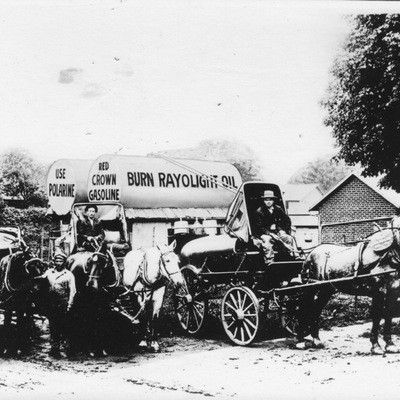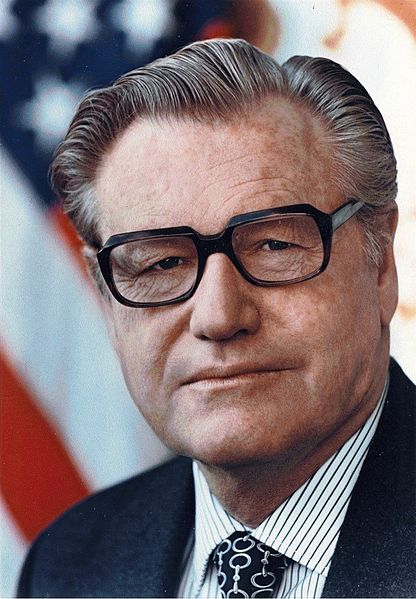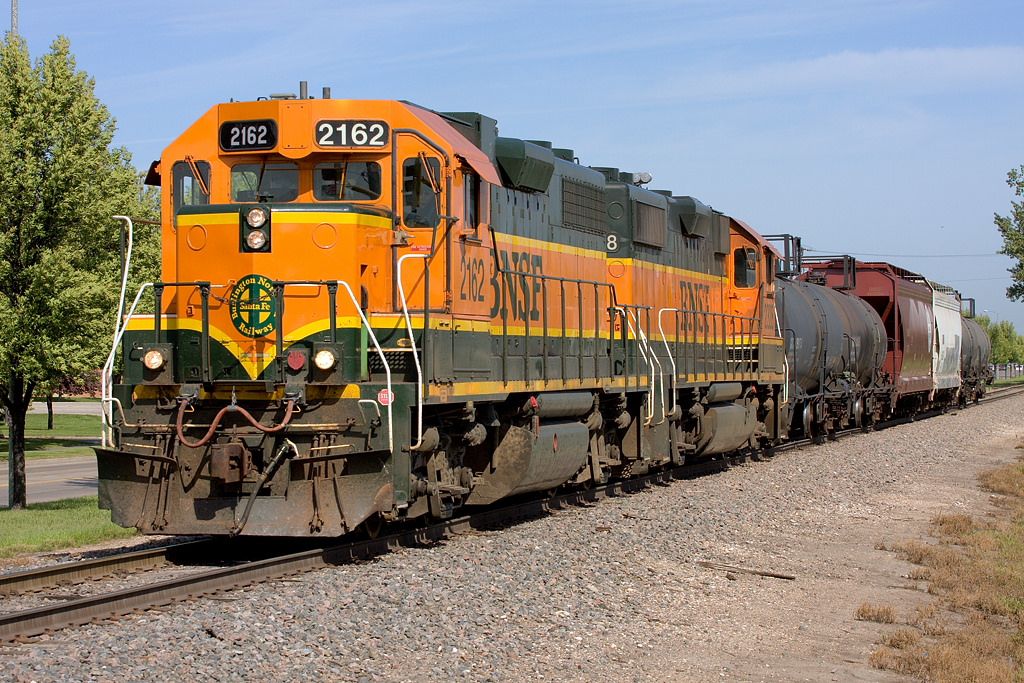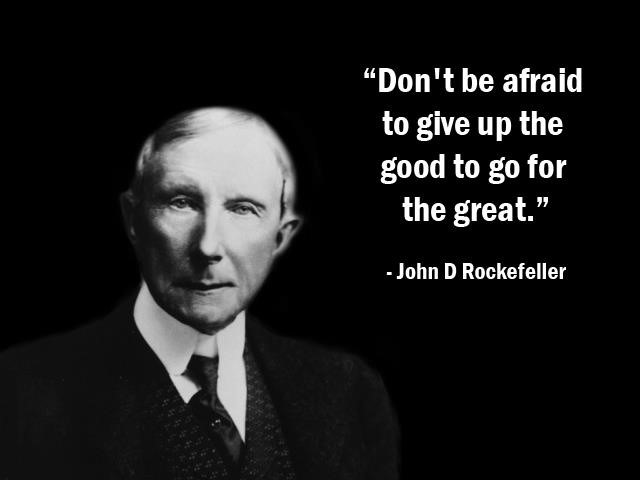Even readers who snoozed through high school or college history class might have heard the name Rockefeller somewhere. To refresh any fuzzy memories, I’ll start by saying that John D. Rockefeller was one of the greatest tycoons in American history. Worth more than a billion dollars by 1900 – when a billion was still serious money – he was certainly the richest man in America at the time. Some historians consider him the richest man in history.
John D. lived from 1839 to 1937, so his remarkable story is receding slowly into the mists of time. Most people today don’t realize that he was not born into money, and didn’t start high on the corporate ladder. In 1855, at age 16, he started work as an office clerk at a Cleveland firm that bought, sold and shipped grain, coal and other commodities. One biographer said Rockefeller considered September 26 – the day he started in that position and entered the business world – so significant, that as an adult he commemorated this “job day” with an annual celebration. (Today, of course, he would be branded as an “extremist” for such a “white supremacist” attitude.)
In the early 1860s Rockefeller’s work involved railroads and the telegraph – both brand-new technologies. In that pre-electricity era people still lit their homes with lamps that used whale-oil – the best fuel for that purpose at the time. The War Between the States was also going on then. This created scarcities of many commodities – including whale oil – and drove their prices very high. The war, speculation, and the extreme difficulty of obtaining whale oil pushed its price to $2.00 a gallon – a level unheard of at a time when many men worked (or soldiered) all day for pay of $1.00. Naturally, the public was outraged, demanding that Mr. Lincoln do something.
Being somewhat preoccupied by the fate of the country, however, Mr. Lincoln did nothing about whale oil. But clever businessmen and ambitious entrepreneurs understood the potential of petroleum – which had been discovered in northwestern Pennsylvania in 1859. They quickly realized that kerosene could be a substitute for whale oil, and began to market it across the nation.
As oil-refining grew into an industry, the price of kerosene crashed, pulling whale oil down with it. By the late 1860s, whale oil was selling for just 10¢ a gallon – its price having been depressed by the widespread competition of kerosene. The whale oil industry was destroyed, and petroleum became the country’s future. (The whales were saved, too.)
John D. Rockefeller had nothing to do with whale oil, but well before the internal-combustion engine’s appearance he grasped the importance of petroleum to the country’s future. Rockefeller and a group of fellow investors invested in a Cleveland refinery to get started in the oil business.
Even more importantly, John D. saw that rail-transport was the key to making petroleum commercially viable. Eventually he and his partners pioneered rail-shipment of kerosene and other oil-products to railheads, and subsequent shipment of those products to retail outlets via other transport media. This reduced the cost of their goods significantly, driving many of their less efficient competitors out of business. The Rockefeller group began to buy bankrupt rival producers for pennies on the dollar, increasing their holdings dramatically.

In the free-wheeling competitive environment of the late 19th century, Rockefeller and his partners exceeded any bounds we generally consider tolerable today. They found that they could hasten the collapse of rival oil firms by raising their rail-transport costs precipitously, or by denying them rail-transport entirely. By the late 19th century, Rockefeller had cornered 90% of all oil-transport rail-car stock in the country. He and his partners used this near-monopoly to drive competing oil-producers to the wall, making them prospects for cheap takeover.
By 1870, Rockefeller and his partners had formed the Standard Oil Trust – today we should call it a “holding company” – of firms that operated semi-independently in various states, while still under the control of Rockefeller’s trust. All this was done in the pre-electronic era, when filing, reporting and accounting were all performed manually, by armies of clerks working with pen and paper. Only the telegraph represented “modern” electronic communications. Although some of his practices were ruthless, Rockefeller’s business accomplishments were truly stupendous.
Because monopolies represented a threat to the nation’s security – especially with respect to oil – Rockefeller’s businesses eventually attracted federal government attention. Only the Feds could deal with multi-state conglomerates like Standard Oil. Laws were passed, and the “trust busters” began to break up the monopolistic trusts. Theodore Roosevelt and William Howard Taft – both Republicans – were the presidents most active in those early 20th-century efforts.
It’s also fair to note that as his fortune grew, Rockefeller became a great philanthropist – donating some $500 million to charitable causes. He also raised a talented and ambitious family. Many of his children and grandchildren have held political offices and performed respectable public service.

I say all this to show my readers how John D. Rockefeller made his fortune, and to help us recognize emerging “Rockefellers” who are using some of the same stratagems as John D. and others of his era.
The newest “Rockefeller” extant is Warren Buffet, President Obama’s zillionaire pal, who made news – and achieved permanent FOB (Friend of Barack) status – by aligning himself with Obama’s tax-the-rich policies. Mr. Buffet famously claimed that his secretary’s income-tax rate was higher than his. Delicately omitting the fact that his secretary probably earns a salary close to $500,000 a year, Mr. Buffet urged passage of legislation to ensure that all “millionaires” are taxed at the same rate that his secretary pays.
During the 2012 presidential campaign, Mr. Buffet’s proposal came to be called the “Buffet Rule.” His suggested legislation didn’t pass, although Mr. Obama did obtain higher tax rates for individuals earning more than $400,000 a year. (No doubt Warren B’s secretary was pleased.)
I call Warren Buffet the “new Rockefeller” because it’s been revealed that he has used some of the same tactics to control oil markets as did the original John D. The difference is that Mr. Buffet has worked hand-in-glove with Mr. Obama’s government, not against it.
Even Hottentots in Africa know that private oil interests have been trying to build a 1,200-mile pipeline (i.e., Keystone) from Hardisty, Alberta to Steele City, Nebraska, to transport crude oil extracted from Canadian shale. The Obama government “studied” the proposed pipeline project for nearly five years, but never approved it – thereby delaying a project that would certainly have meant thousands of American construction jobs, plus valuable Midwest refining of hundreds of thousands of barrels of oil per day. Besides the Canadian oil, Keystone would carry 100,000 barrels of North Dakota shale-oil every day.
Environmentalists fervently opposed Keystone on grounds that it would exacerbate climate change (i.e., Global Warming) by increasing CO2 emissions. But Keystone proponents argued that the climate hadn’t warmed (or cooled) in 15 years. Besides, even the State Department’s own study at the time showed that the Canadian oil would be extracted, refined and used anyway – whether or not Keystone was built – since the Canadians would ship it to their west coast by other means. A Harris poll taken in 2013 showed that 82% of Americans believed Keystone would be in the nation’s interest. Of course, Mr. Obama knew all this. So why did he hold up the approval?
As usual, we should follow the money. Mr. Buffet had contributed heavily to Mr. Obama’s political campaigns – perhaps more than $1 million. OK, so he and Obama were great pals. We knew all that. But less well known was WB’s opposition to Keystone. Why was that? Is he a closet environmentalist? No, it’s still the money. With tycoons, it’s always The Money.
North Dakota oil was mostly being shipped via the Burlington, Northern and Santa Fe railroad (as it still is). The Berkshire Hathaway (BH) conglomerate owns that railroad, and BH is controlled by (guess who?): Warren Buffet. Burlington, Northern and Santa Fe has been doing a nice business shipping North Dakota crude. But Keystone would have disrupted that business and cost Mr. Buffet a bundle. This is how the dots were (and are) connected.
Besides owning a railroad that ships North Dakota crude, Berkshire Hathaway also owns Union Tank Car – one of the biggest makers of railroad oil tank-cars. That business is also booming because there hasn’t been enough shipping capacity for the Canadian shale-oil. According to Toby Kolstad (president of the consultant firm Rail Theory Forecasts LL), “People who want to ship oil can’t get [rail tank cars]. They’re desperate to get anything to move crude oil.”

So a powerful tycoon opposes an oil pipeline that would certainly impact his railroad oil-transport business. He makes big political donations to a president who subsequently delays the pipeline by “studying” it (indefinitely). Meanwhile, the same tycoon controls who gets railroad oil tank-cars, and how many. (Does all this sound vaguely familiar?)
When Donald Trump became president, on January 20, 2017, he immediately authorized construction of the Keystone pipeline. This might furnish a clue to why Warren Buffet joined the cabal that wanted to get rid of Mr. Trump. When their effort succeeded, Joe Biden’s first executive order stopped Keystone construction. (Who says government can’t act quickly?)
William C. Triplett II – former counsel to the Senate Foreign Relations Committee – wrote: “A chart of dollars out of Berkshire Hathaway and into the Democratic National Committee would look very ugly.”
Will Big Media “discover” the connection between Democrats, Warren Buffet, and the stalled Keystone pipeline? (Color me “doubtful.”) Imagine the media and political uproar, should a Republican president be mixed up in such an intrigue. There’s big money involved here, and powerful financial interests who want it to keep flowing. It’s another scandal-in-waiting.
The red flag should go up on this, but don’t hold your breath. The FBI and DoJ are far too busy raiding Mr. Trump’s home, tracking down parents who complain at school board meetings, and rooting out the dreaded White Supremacists. As Yakob Smirnoff would say, “What a country!”
“Those who want to get rich fall into temptation and a trap and into many foolish and harmful desires that plunge people into ruin and destruction. For the love of money is a root of all kinds of evil. Some people, eager for money, have wandered from the faith and pierced themselves with many griefs.” (I Timothy 6:9-10)


